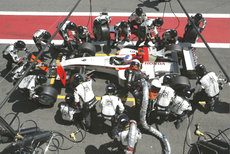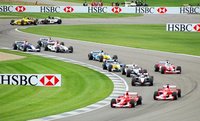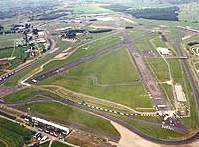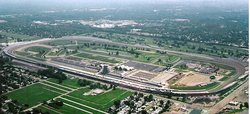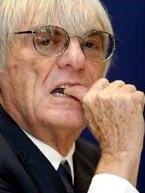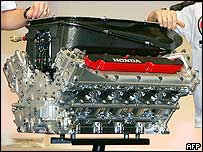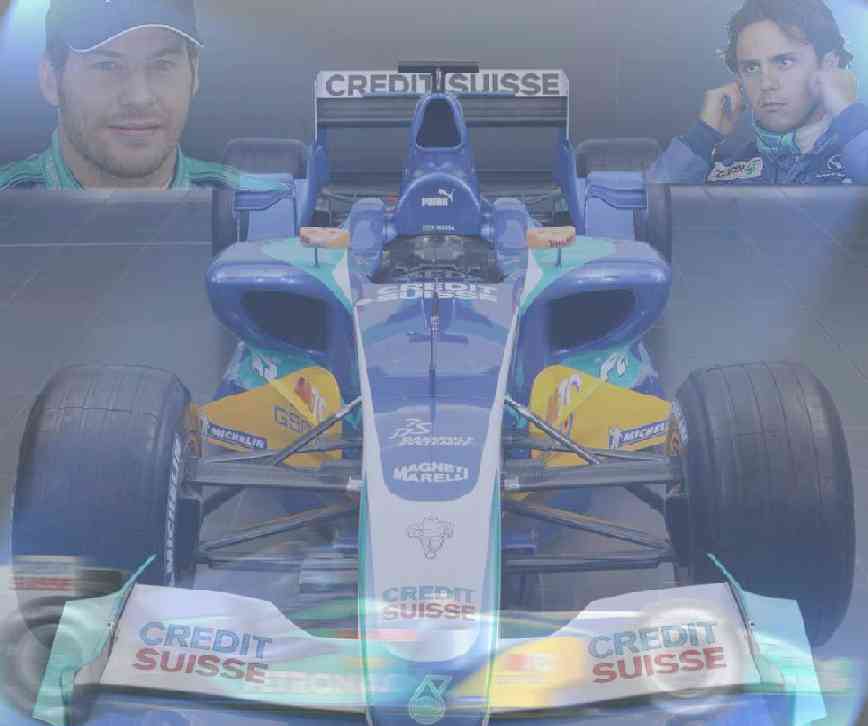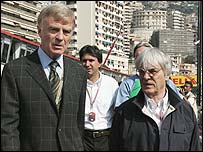|
FORMULA ONE
|
|||||||||||||||
|
HOME | BIOLOGY | FILMS | GEOGRAPHY | HISTORY | INDEX | MUSIC | THE BOAT | SOLAR BOATS | SPONSORS |
|||||||||||||||
|
FORMULA ONE - Many people see Formula One (F1) racing as the very best in the whole of motorsport. It's actually a set of rules for single-seater racing cars. The rules apply to how much the cars can weigh and how they're raced.
Formula One, abbreviated to F1 and also known as Grand Prix racing, is a form of formula racing and the highest class of single-seat open-wheel auto racing. It is a worldwide sport, involving an annual World Drivers Championship and World Constructors Championship, and is the most expensive sport in the world, as annual team budgets average in the hundreds of millions of US dollars. It is based around a series of races; 19 in the 2005 Formula One season), known as grands prix, on custom-constructed road courses or closed-off street circuits. The sport is regulated by the FIA, Fédération Internationale de l'Automobile, and is generally promoted and controlled by Bernie Ecclestone.
Racing
and Strategy A
Formula One Grand Prix event spans an entire weekend, beginning with the
free practice on Friday. Two qualifying sessions determine a driver’s
position on the starting grid for Sunday’s race. For the first
qualifying session held on Saturday, drivers set a timed "flying
lap" on the empty track with unrestricted fuel load. The drivers
take off from the pits within a minute off each other. The start order
for the qualifying lap is determined by the previous race’s finish
order, with the driver on pole position going last. For the first
qualifying session of the season the previous year’s championship
standing will determine the order.
Pit Stop
Rise in popularity
1981
saw the signing of the first Concorde
Agreement, a contract which bound the teams to compete until its
expiration and assured them a share of the profits from the sale of
television rights, bringing an end to the FISA-FOCA war and contributing
to Bernie Ecclestone's
eventual complete financial control of the sport.
Popularity
Formula
One went through a difficult period in the early 2000s.
Viewing figures dropped, and fans expressed their loss of interest due
to the dominance of Michael
Schumacher and Ferrari. At present, smaller teams suffer from
spiralling costs. Safety also remains a key issue. As such, many want to
see rule changes to deal with these issues.
The Post-War years and Formula One
In 1946, following World War II, there were only four races of Grand Prix caliber held. Rules for a Grand Prix World Championship had been laid out before World War II, but it took several years afterward until 1947 when the old AIACR reorganized itself as the F餩ration Internationale de l'Automobile or "FIA" for short. Headquartered in Paris, France, at the end of the 1949 season it announced that for 1950 they would be linking several national Grands Prix to create Formula One with a World Championship for drivers, although due to economic difficulties the years 1952 and 1953 were actually competed in Formula Two cars. A points system was established and a total of seven races were granted championship status including the Indianapolis 500. The first World Championship race was held on 13 May at Silverstone in the United Kingdom.
The Italians once again did well in these early World Championship races, both manufacturers and drivers. The first World Champion was Giuseppe Farina, driving an Alfa Romeo. Ferrari appeared at the second World Championship race, in Monaco, and has the distinction of being the only manufacturer to compete during the entire history of the sport, still competing in 2004. (Follow the History of the World Championship for Drivers link for more history after 1950.)
Indianapolis - United States Grand Prix
Drivers and constructors
Formula One teams must build the chassis in which they compete, and consequently the terms "team" and "constructor" are more or less interchangeable; this requirement distinguishes the sport from "spec series" such as IRL, CART, Formula 3000 and NASCAR. In its early years, F1 teams sometimes also built their engines (as with BRM, Cooper and Matra). It has since become rare that a team should construct its own engine, and with the involvement of major car manufacturers such as BMW, Daimler Chrysler, Renault, Toyota, and Honda, such privately-built engines have become less competitive. Currently, only Ferrari, Renault and Toyota build their own engine as well as the car. For a good part of Formula One's history, only Ferrari built the entire car, including engine.
Early manufacturer involvement came in the form of a "factory team", i.e. one owned and staffed by a major car company, such as those of Alfa Romeo, Peugot or Renault. Companies such as Climax, Repco, Cosworth, Judd and Supertec, which had no direct team affiliation, often sold engines to teams who could not afford to manufacture them. As the manufacturer's deep pockets and engineering ability took over, these collaborations largely died out in favour of the present system in which one manufacturer supports one team. After virtually disappearing in the 1970's and early 1980's (when the grids generally consisted of two Ferraris and the remainder Cosworth Powered), factory teams are on a comeback with Toyota, Ferrari (FIAT), Renault owning their own teams and BMW and Honda following suit by purchasing other teams. Honda now owns part of B.A.R., while BMW just recently purchased Sauber. Others such as Daimler-Chrysler (and at least until the end of this season BMW) provide engines and sponsorship for privately-owned teams in return for prominent advertisement on their team clothing and car livery. The only remaining commercial engine-manufacturer is Cosworth, which supplies engines for Red Bull Racing and Minardi in 2005.
The sport's 1950 debut season saw eighteen teams compete, but due to rising costs many dropped out quickly. In fact, such was the scarcity of competitive cars for much of the first decade of Formula One, formula two cars were admitted to fill the grids. Ferrari is the only still-active team which competed in 1950, and during the 2004 season only ten teams remained on the grid, each fielding two cars. Although teams rarely disclose information about their budgets, it is estimated that they range from $75 to $500 million U.S. dollars, depending on the team.
Entering a (new) team in the Formula One World Championship requires a £25 million up-front payment to the FIA, which is then repaid to the team over the season. As a consequence, constructors desiring to enter Formula One often prefer to buy an existing team: B.A.R.'s purchase of Tyrrell) and Midland's purchase of Jordan permitted both of these teams to sidestep the large deposit.
The FIA has awarded the Formula One World Drivers Championship annually since 1950 and the Formula One World Constructors Championship annually since 1958. German driver Michael Schumacher holds the record for having won the most Drivers' Championships (seven) and Ferrari holds the record for having won the most Constructors' Championships (fourteen). Jochen Rindt has the distinction of having been the only posthumous World Champion. Each car is assigned a number.
The previous season's World Drivers Champion is given the number 1, with his team mate given the number 2. Numbers are then assigned according to each team's position in the previous season's World Constructors Championship. There have been exceptions to this rule, such as in 1993 and 1994, when the current World Drivers Champion was no longer competing in Formula One. In this case the drivers for the team of the previous year's champion are given numbers 0 and 2. The number 13 has not been used since 1974, before which it was occasionally assigned at the discretion of individual race organizers. Prior to 1996, only the world championship winning driver and his team generally swapped numbers with the previous champion - the remainder held their numbers from prior years, as had been originally set at the start of the 1974 season. Thus, for many years, Ferrari held numbers 27 & 28, for example, Williams held numbers 5 & 6, McLaren held numbers 7 & 8, Renault held numbers 15 & 16, and Ligier held numbers 25 & 26, regardless of their finishing position in the world championship. As privateer teams quickly folded in the early 90's, numbers were frequenly shuffled around, until the current system was adopted in 1996.
Silverstone - racing circuit United Kingdom
Grands Prix
The number of Grands Prix held in a season has varied over the years. Only seven races comprised the inaugural 1950 season; over the years the calendar has more than doubled in size. Though the number of races stayed at sixteen or seventeen since the 1980s, it has reached nineteen in 2005.
Six of the original seven races took place in Europe; the only non-European race in 1950 was the Indianapolis 500, which, due to lack of participation by F1 teams, was later replaced by the United States Grand Prix. The F1 championship gradually expanded to other non-European countries as well: Argentina hosted the first South American grand prix in 1953, and Morocco hosted the first African World Championship race in 1958. Asia (Japan, 1976) and Oceania (Australia, 1985) followed as well. The current nineteen races are spread over the continents of Europe, Asia, Oceania, North America, and South America.
Traditionally, each nation has hosted a single grand prix that carries the name of the country. If a single country hosts multiple grands prix, they receive different names; for example, Germany, Spain and Britain have at various times held a second race known as the European Grand Prix. The grands prix, some of which have a history that predates the Formula One World Championship, are not always held on the same circuit every year. The British Grand Prix, for example, though held every year since 1950, alternated between Brands Hatch and Silverstone from 1963 to 1986. The only other race to have been included in every World Championship season is the Italian Grand Prix; it has occurred at Monza, except when it was at Imola(which now hosts the San Marino Grand Prix) in 1980.
One of the newest races on the Grand Prix, held in Bahrain, represent Formula One's first penetration into the Middle East with a high tech purpose built desert track. The Bahrain Grand Prix along with other new races in China present new opportunities for the growth and evolution of the Formula One Grand prix franchise while also raising the bar for other Formula One racing venues around the world.
Circuits
Most of the currently used circuits are specially constructed for competition. The only real street circuit is the Circuit de Monaco, used for the Monaco Grand Prix, though a street race in London has been discussed. Some of the other circuits are also completely or partially laid out on public roads, such as those of Spa-Francorchamps or Montréal. The glamour and history of the Monaco race are the primary reasons the circuit is still in use, since it does not meet the strict safety requirements imposed on other tracks. Three times World champion Nelson Piquet famously described racing in Monaco as "flying with a helicopter in your living room." However, new tracks such as the Bahrain International Circuit provide the first dimensions and challenges for Formula One drivers on the a desert track (since the Grandes Prix of Morroco and Penya Rhin in the 1950's) with its multiple overtaking opportunities and associated climatic distinctions to other circuits.
Indianapolis Motor Speedway
Circuit design to protect the safety of drivers is becoming increasingly sophisticated, as exemplified by the new track in Bahrain. Where in the 1950s a driver was lucky to find a strategically placed strawbale to absorb his impact, modern Formula One circuits feature gravel traps and tyre barriers to reduce risk of injury in crashes. This is an ongoing task - after the deaths of Ayrton Senna and Roland Ratzenberger at Imola during the 1994 season, the FIA mandated further changes to circuits. These were mostly aimed at better matching how fast a car is travelling when an accident occurs with the runoff space available for it to decelerate and at improving the ability of barriers to safely absorb the energy of a crash. An ongoing complaint of long time F1 fans is the emaciation of the world's greatest circuits in order to satisfy sometimes arbitrary demands from the FIA. While circuit safety is of prime importance, this can often be achieved without the reduction of the modern circuit to parade route status.
A typical circuit usually features a stretch of straight road on which the starting grid is situated. The pit lane, where the drivers stop for fuel and tyres during the race, and where the constructors work on the cars before the race, is normally located next to the starting grid. The layout of the rest of the circuit varies widely. Some of the curves on circuits have become well known on their own, such as the high-speed Eau Rouge at Spa-Francorchamps, and prior to it's emasculation with chicanes, the tamburello corner at Imola and the Curva Grande at Monza. Particularly lamented are the long lost circuits at Zandvoort in Holland and Kyalami (old Circuit) in South Africa
The future of Formula One
Formula One went through a difficult period in the early 2000s. Viewing figures dropped, and fans expressed their loss of interest due to the dominance of Michael Schumacher and Ferrari, as well as the reduction of the circuits owing to new safety regulations. At present, smaller teams suffer from spiralling costs. Safety also remains a key issue. As such, many want to see rule changes to deal with these issues.
Throughout the 2004 season, Formula One Management president Bernie Ecclestone repeatedly voiced his disapproval of the Silverstone Circuit, and suggested that unless its owners, the British Racing Drivers Club, modernise the facilities, the British Grand Prix would not appear on the 2005 schedule. Following failed negotiations with BRDC president Jackie Stewart in October 2004, Ecclestone announced the race's removal from the next season's provisional calendar. The BRDC and Ecclestone have since come to an agreement to extend the British Grand Prix at Silverstone for another five years, through 2009.
Due to financial difficulty, the future of the French Grand Prix also remains in doubt. However, a Turkish Grand Prix will take place in Istanbul, Turkey for the first time in 2005, and a Mexican Grand Prix has been planned for 2006.
Bernie Ecclestone's £1m gift caused trouble for Labour
Bernie Ecclestone has also made a promise that F1 will return to South Africa within five years. He has begun talks with a consortium planning to build an F1 circuit in Cape Town. Ecclestone has also made a pledge to hold a Russian Grand Prix either in Moscow or St. Petersburg in the near future. He is in nearly continuous talks with potential race promoters all around the world. It is believed that one significant factor that has F1 searching for venues outside of Europe is the spread of laws in Western nations prohibiting cigarette advertising in sport.
The future of the United States Grand Prix at Indianapolis is now in serious doubt after the 2005 race saw only the six Bridgestone-shod cars take the green flag (Ferrari, Jordan and Minardi), due to concerns about the safety of the Michelin tires which equip the 14 remaining cars (McLaren, Renault, Williams, BAR, Toyota, Red Bull Racing and Sauber). However, Ecclestone is reportedly trying to bring the U.S. Grand Prix to back to Las Vegas, where it met with lukewarm reception from 1981-1983.
Rule changes
Every year the bosses of Formula One change some of the sport's rules to try and make the racing more exciting. The changes for the 2005 season are some of the biggest made for years, to include TYRES, ENGINES and QUALIFYING:-
For 2005, there has been a radical overhaul of the technical regulations. Drivers are only able to use one set of tyres per race, with pit-stops for tyre changes being banned (unless the tyre is damaged). Restrictions have also been placed upon downforce in an attempt to slow the cars down. As well, each engine must be used for two consecutive races.
A revised qualifying format was used for the first part of 2005 season. For each race, two separate sessions were run: the first qualifying session took place on the day before the race (Saturday) at 13:00; the second qualifying session started four hours before the start of Sunday's race; in both qualifying sessions each driver drove a single timed lap. The starting order for the first qualifying session was the previous race classification reversed; in the second qualifying session it was the first session classification reversed. The starting grid was drawn up according to the fastest aggregate time of each driver, taking into account both qualifying sessions. Cars were required to carry their race fuel in the second qualifying session; refuelling was not allowed between this and the race.
Formula One engine
Starting from the Grand Prix of Europe 2005, a new qualifying method has replaced the two-day aggregate qualifying. This new format consists of one Saturday qualifying session on the day before the race at 13:00 CET, except in the races taking part in the USA and in Canada where it starts at 12:00 (local time). The starting order for this qualifying session is the previous race classification reversed. Cars must carry race fuel amounts during this Saturday afternoon session and refueling is not permitted between qualifying and the race.
Beginning with the 2006 season, the power of engines will also be decreased. A 2.4L V8 will be used instead of the 3.0L V10. However, some teams will be allowed to continue using the V10 with a rev limiter in order to cut costs. The switch to smaller engines may not mean a significant decrease in power, however, because some engine suppliers have already indicated that their smaller V8s can rev higher than the 19,000rpms normal for the current V10s. In the long run, the FIA intends to introduce greater restrictions on testing and the introduction of standardized electronic units and tyres. Small teams
The Ford Motor Company's decision to pull out of Formula One exposed the vulnerability of some small teams. Jaguar Racing was put up for sale and bought by Red Bull; it is now known as Red Bull Racing. As for other teams, Jordan and Minardi both relied on Ford's Cosworth engines. Jordan now have a deal to use Toyota engines. Minardi, on the other hand, will continue to use Cosworth engines under Cosworth's new owners.
Changes for 2006 are expected to include Jordan being rebadged as Midland F1. Similarly, in June 2005, BMW bought a majority stake in Sauber and intends to run the team as a factory entry in 2006. It is not known at this time if BMW will continue to supply engines to the Williams team in 2006.
Who can race in formula one
A Grand Prix driver has to have a special driving licence called a 'Super Licence'. He gets it when he's reached a certain standard at junior level. He also has to have a contract with a Formula One team in the World Championship.
Who's racing in 2005
Ferrari
McLaren
Williams
Sauber
Jordan
BAR-Honda
Renault
Red Bull
Minardi
Toyota
References
See also
LINKS
Official sites
News and reference
Insight and commentary
Grand Prix races:See also:
Grand Prix drivers:
Some of the notable drivers of the Grand Prix motor racing era included a few women who competed equally with the men:
Antonio Ascari - (Italy) Robert Benoist - (France) Clemente Biondetti - (Italy) Georges Boillot - (France) Manfred von Brauchitsch (Germany) Malcolm Campbell - (England) Rudolf Caracciola - (Germany) Louis Chiron - (Monaco) Albert Divo - (Italy) Ren頄reyfus - (France) Philippe ɴancelin - (France) Luigi Fagioli - (Italy) Giuseppe Farina - (Italy): (he became the 1st Formula One champion Enzo Ferrari - (Italy) Jules Goux - (France) Elizabeth Junek - (Czechoslovakia) Hermann Lang - (Germany) Christian Lautenschlager - (Germany) Emilio Materassi - (Italy) Felice Nazzaro - (Italy) Hell頎ice - (France) Tazio Nuvolari - (Italy) Kay Petre - (Great Britain) Charles Pozzi - (France) Georges Philippe (Baron Philippe de Rothschild) - (France) Bernd Rosemeyer - (Germany) Richard Seaman - (England) Henry Segrave - (England) Raymond Sommer - (France) Hans Stuck - (Germany) Ferenc Szisz - (France) Achille Varzi - (Italy) Emilio Villoresi - (Italy) Luigi Villoresi - (Italy) William Grover-Williams - (France) Jean-Pierre Wimille - (France)
VEHICLE HISTORY A - Z
REFERENCES and LINKS:
Fédération Internationale de l'Automobile - Wikipedia, the free ... The Fédération Internationale de
l'Automobile, commonly referred to as the FIA, ...
but is occasionally rendered as International Automobile Federation.
...
FISITA: The International Federation of Automotive Engineering ... International Federation of
Automotive Engineering Societies. About FISITA ... Mondial de l'Automobile.
Paris, France. 4 - 6 October 2006. International ...
Automotive Diary - FISITA: The International Federation of ... International Federation of
Automotive Engineering Societies. About FISITA ... Mondial de l'Automobile.
30 September - 15 October 2006, Paris, France ...
FEDERATION INTERNATIONAL DE LA AUTOMOBILE THE WORLD GOVERNING BODY ... The Fédération Internationale de
l'Automobile is a Federation recognised by the International
Olympic Committee ... International Directory of Design: Federation Belge de l'Industrie ... Federation Belge de l'Industrie
de l'Automobile et du Cycle Bruxelles (Brussels),
Brabant, Belgium. [ FEBIAC, Belgian Federation of Automobile
& Two-Wheeler ...
International Automotive Associations :: SIAM Profile >> International
Automotive Associations ... BELGIUM, Federation Belge
des Industries de L'Automobile et du Cycle Reunies (FEBIAC)
...
Taking Your Car Overseas - Australian Automobile Association The Australian Automobile
Association (AAA) supports and coordinates the ... de Tourisme
(AIT) and the Federation Internationale de'l Automobile
(FIA), ...
WTO Business Council - Transport Companies FÉDÉRATION INTERNATIONALE DE L'AUTOMOBILE
(FIA). Address: 2 chemin de Blandonnet - Case Postale ... International
organization. Main field of activities: ...
A taste for adventure capitalists
Solar Cola - a healthier alternative
|
|||||||||||||||
|
This
website
is Copyright © 1999 & 2006 NJK. The bird |
|||||||||||||||
|
AUTOMOTIVE | BLUEBIRD | ELECTRIC CARS | ELECTRIC CYCLES | SOLAR CARS |
|||||||||||||||
